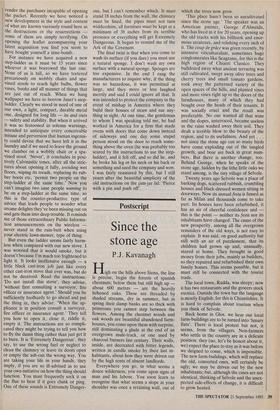Postscript
Since the stone age
P.J. Kavanagh
High on the hills above Siena, the line is precise, begin the forests of spanish chestnuts; below them but still high up about 600 metres — are the heavily lichened oaks. These are threaded by shaded streams, dry in summer, but in spring their damp banks are so thick with primroses you cannot step between the flowers. Among the chestnut woods and oak woods are beautiful abandoned farm- houses, you come upon them with surprise, still dominating a glade at the end of an overgrown mule-track, or one used by charcoal burners last century. Their walls, inside, are decorated with bitter legends, written in candle smoke by their last in- habitants, about how they were driven out by the high rents of absent landlords.
Everywhere you go, in what seems a donee wilderness, you come upon signs of man and his labour. You soon learn to recognise that what seems a slope at your shoulder was once a retaining wall, out of which the trees now grow.
`This place hasn't been so uncultivated since the stone age.' The speaker was an American painter, George d'Almeida, who has lived in it for 20 years, opening up the old tracks with his billhook and enor- mous secateurs, and relishing every inch of it. The coup de grace was given recently, by intensive viticulturalists, sometimes huge conglomerates like Seagrams, for this is the high region of Chianti Classico. They bulldozed away what ancient terracing was still cultivated, swept away olive trees and cherry trees and small tomato gardens, took away the patterned variety of the open spaces of the hills, and planted vines and more vines right up to the doors of the farmhouses, many of which they had bought over the heads of their tenants. It was socially cruel and the result was predictable. No one wanted all that wine and the slopes, unterraced, became useless as the rains washed away their soil. They dealt a terrible blow to the beauty of the region, and to its usefulness. And yet . . . not since the stone age can so many birds have come exploding out of the tangled growth, and boar are back in great num- bers. But there is another change, too. Behind George, when he speaks of the stone age, hidden by the lithe little oaks we stand among, is the tiny village of Selvole.
Twenty years ago Selvole was a place of barking dogs, scattered rubbish, crumbling houses and black-dressed women sitting in doorways. Now its annual festa is famed as far as Milan and thousands come to take part. Its houses have been refurbished, it has an air of cheerful confidence and this is the point — neither its festa nor its inhabitants have changed. The cause of the new prosperity, among all the overgrown reminders of the old ways, is not easy to explain. It was said, on good authority but still with an air of puzzlement, that its children had grown up and, unusually, stayed at home. They brought in good money from their jobs, mainly as builders, so they repaired and refurbished their own family homes. This seems possible, but it must still be connected with the tourist trade.
The local town, Radda, was sleepy; now it has two restaurants and the grocers stock exotica. Outside the town bar the language is mostly English, for this is Chiantishire. It is hard to complain about tourism when you think of Selvole.
Back home in Glos. we hear our local farm-buildings are to be turned into 'luxury flats'. There is local protest but not, it seems, from the villagers. Non-farmers who settle in the country are in a delicate position: they (no, let's be honest about it, we) expect the place to stay as it was before we deigned to come, which is impossible.
The new farm-buildings, which will replace the old, converted ones, will certainly be ugly; we may be driven out by the new inhabitants; but, although the cases are not identical, thinking of Selvole and the unex- pected side-effects of change, it is difficult to grow heated.














































 Previous page
Previous page